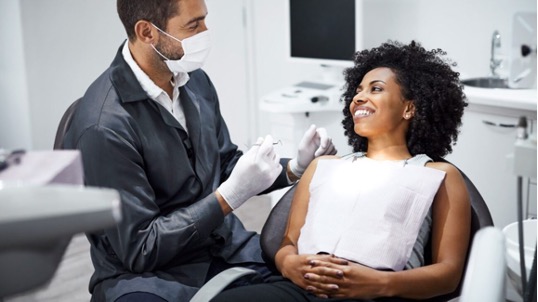Almost 60% of the public suffer from dental fear and anxiety.
As a result of this statistic, many dental offices throughout the world advertise to the public that they “cater to cowards.” This phrase is to convey the message that they compassionately manage the anxious patient.
A patient’s anxiety shows up as dental avoidance. They avoid making an appointment or they do not show up; leading to severe oral health complications and a low quality of life. Within a dental office, anxious patients can become irritable or uncooperative. These responses are problematic not only for the patient but also dental professionals.
What causes dental anxiety?
Dental anxiety can be caused by a past traumatic dental experience, other traumatic incidence, abuse or other healthcare experience or previous trauma. This fear does not have to last. Dentists have the expertise, sensitivity and appropriate technology to make your visit as pleasant and comfortable as possible.
Here are several strategies dentists apply to effectively manage, treat and encourage anxious dental patients: These techniques have been proven to be valuable for this typical patient.
The main focus, is to be sensitive to the patient’s needs and concerns. Dentist must be compassionate. Also, the dentists and their staff must reassure patients that they have the patient’s best interest at heart. The dental team can help patients through their dental anxiety by using a number of calming techniques.
Caring and communication
For a patient with dental anxiety empathy and understanding go a long way. Taking time to listen to a patient’s voice their fears and concerns can make the patient feel welcomed and ultimately relaxed.
A good dentist must be an effective communicator. A patient’s relationship with his/her dentist and dental team is just like any other relationship. It benefits from openness and honesty. Patients should be encouraged to ask questions and they should be kept informed during the dental procedure.
An effective way to do this is the tell-show-do technique. The “tell” part of the technique involves verbal explanations of the overall procedure as well as steps along the way. The “show” includes demonstrations for the patient of the visual, auditory, olfactory senses. The “do” part of the technique is the completion of the dental procedure—without deviating from the plan laid out in “tell” and “show”. Verbally checking on the patient before, during and after the dental procedure is a great way to establish a sensitive and empathetic approach.
Control and distraction
Dentists and team members have found that giving patients a sense of control over their appointment is beneficial in managing dental anxiety. For example, allowing the patient to decide when work begins regarding their procedure.
Some dentists allow anxious patients to hold the saliva suction, giving them control over when they need to rinse and spit. Also, patients are encouraged to express when they need a break, using appropriate hand signals.
Offering distractions is another way to allow patients to manage their dental visit while at the office. Calming, engaging music throughout the dental office helps, as does encouraging patients to bring their own headphones and playlists. Equipping each dental chair or dental suite with a television is another strategy some technology savvy offices have used.
Scheduling and esthetics of environment
Scheduling as well as office ambiance can play a significant role in reducing dental anxiety. From the waiting room to the chair, anxious patients take in everything they see, hear, and smell. In some cases, this can worsen a patient’s mental state.
It is important to schedule a patient with dental anxiety as early as possible in the morning. The is because an afternoon appointment allows the patient more time to worry. The dental team should seek to seat the patient as quickly as possible to avoid the unnecessary fretting in the waiting room for an extended period.
Additional ways dentists can establish a calming office environment:
- Adorning walls with relaxing posters and pictures;
- Use technology for educational purposes in a non-threatening way
- Avoid the smell of medicine
- Avoid loud sounds
- Offering patients refreshments (water, tea, coffee or a treat)
- Offering the patient a mild sedative helps to manage any anxiety before and during a procedure.
Dental anxiety can be harmful to patients and frustrating for the dental professionals working to care for them. The dental team must take deliberate steps to alleviate a patient’s anxiety in both the short and long term.
Easing a patient’s anxiety through clear communication has proven to be an effective tool in managing the anxious patient. This comes alive when dentists demonstrate understanding and empathy through trusting words and actions. The dentist and the entire team should invest the time and focus on the patient. This goes a long way in empowering patients to seek the necessary dental care in their journey toward good health and wellness.
Dr. Kendal V. O. Major is Founder and CEO of Center for Specialized Dentistry which is a comprehensive family dental practice operating in Nassau and Freeport. He is the first Bahamian Specialist in gum diseases and dental implants since 1989. He also is a certified Fast braces provider. His practice is located at 89 Collins Avenue, Nassau at (242)325-5165 or [email protected]

Children should see a dentist by age two to avoid unwarranted fears

“Thumbs Up” Most dental visits are pleasant and rewarding

Seeing a dentist is an important part of maintaining good health





